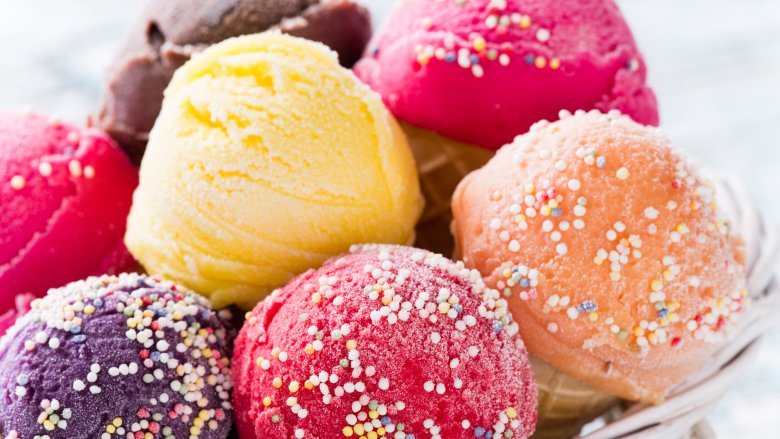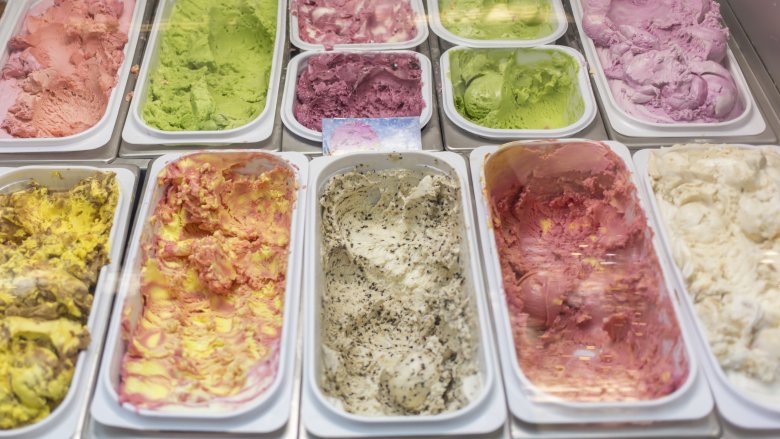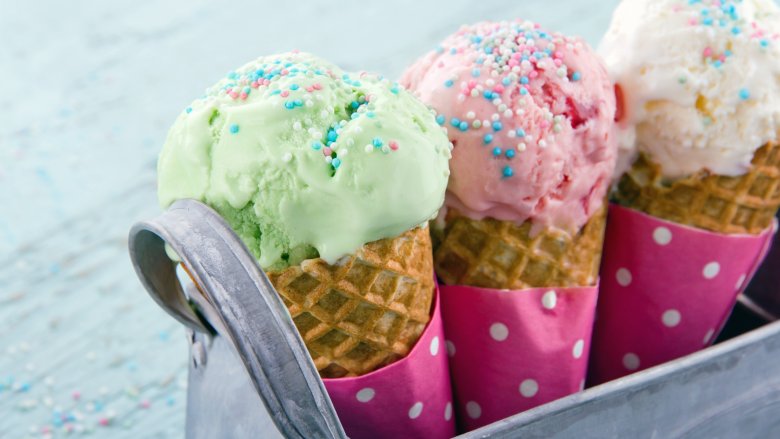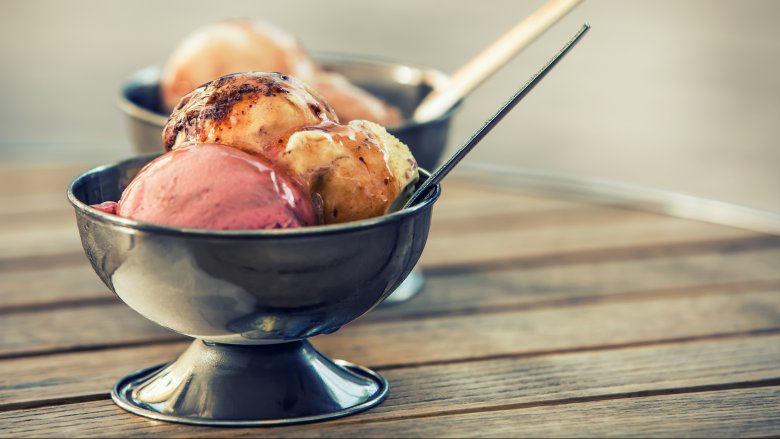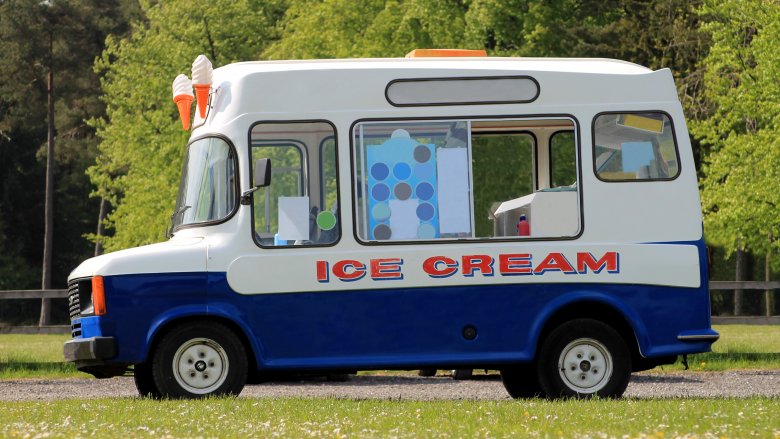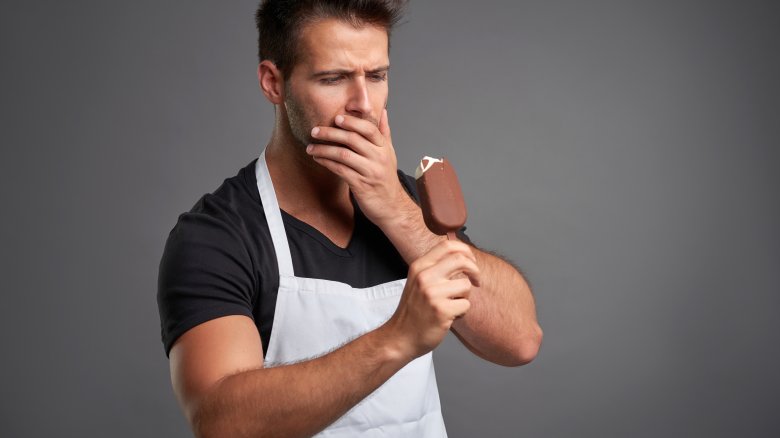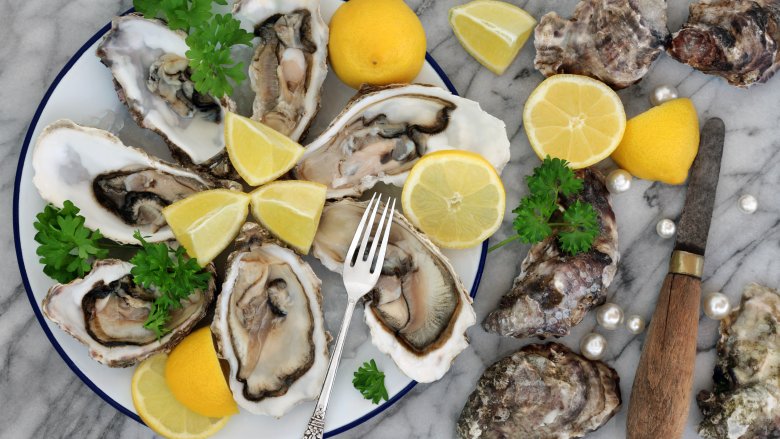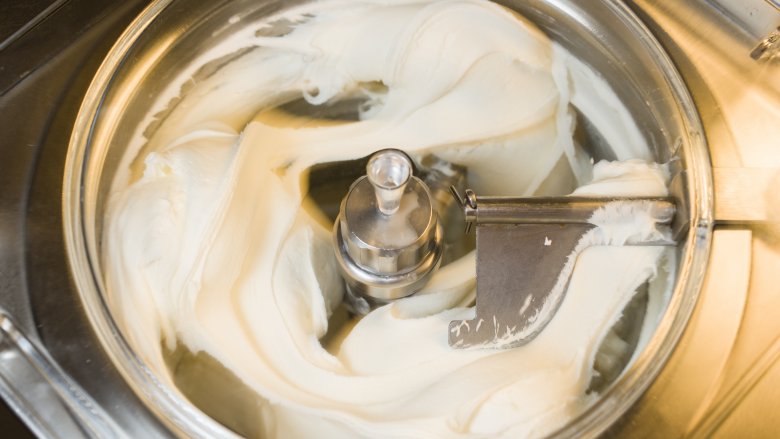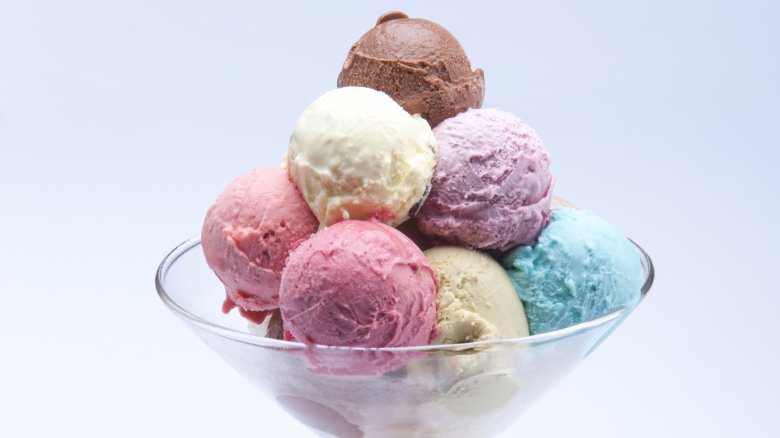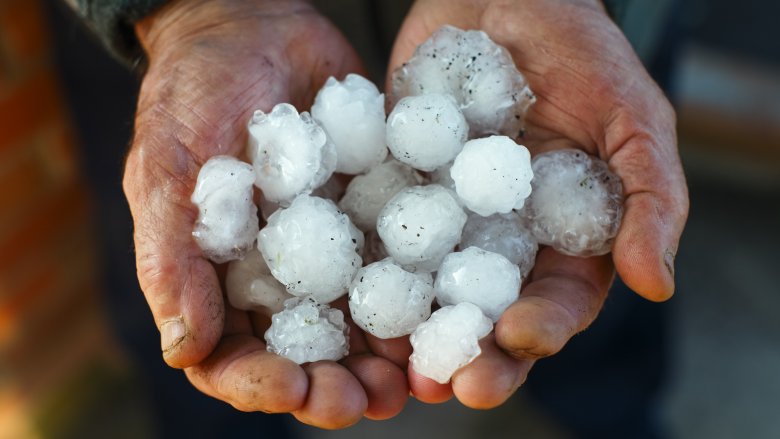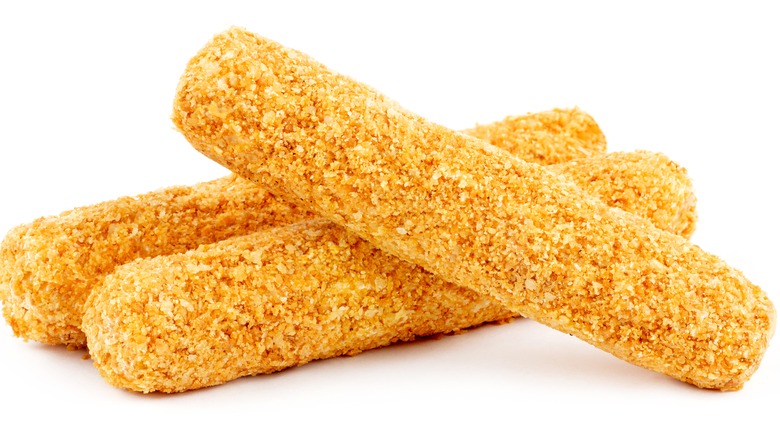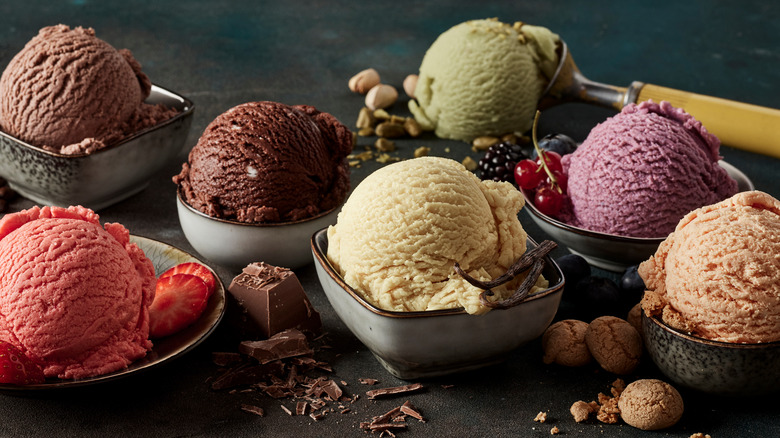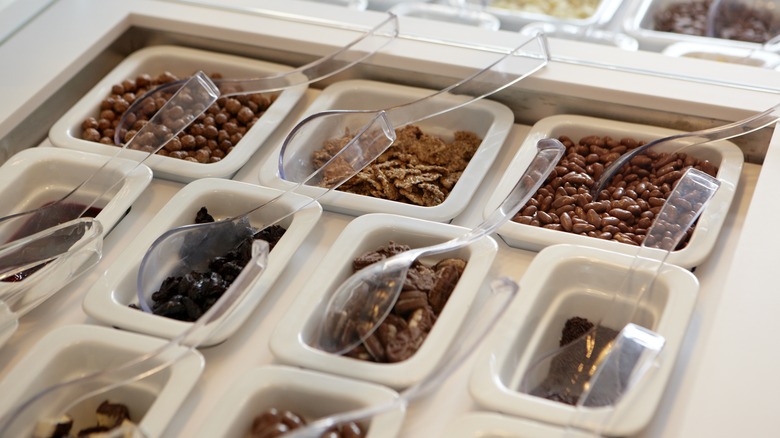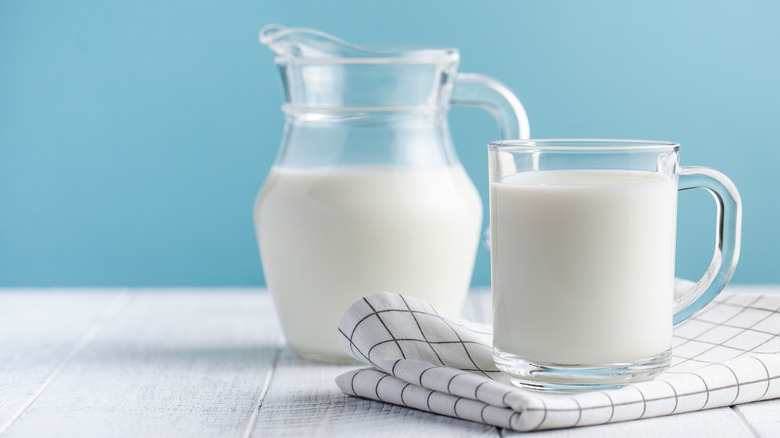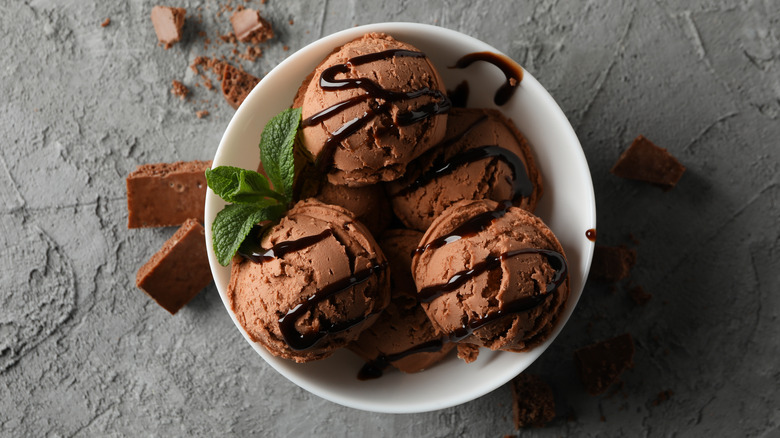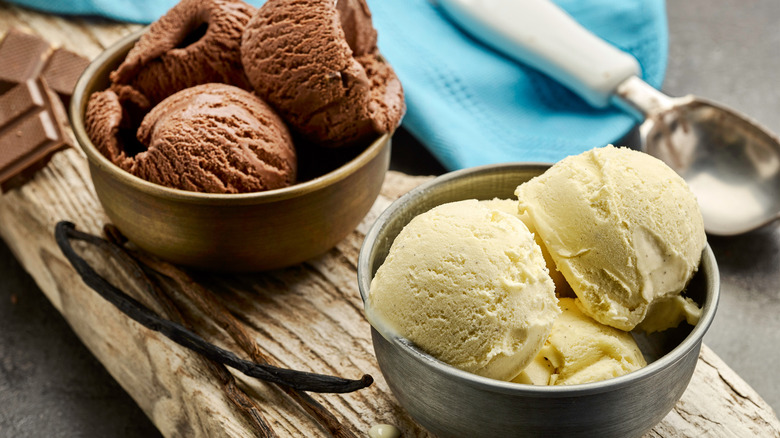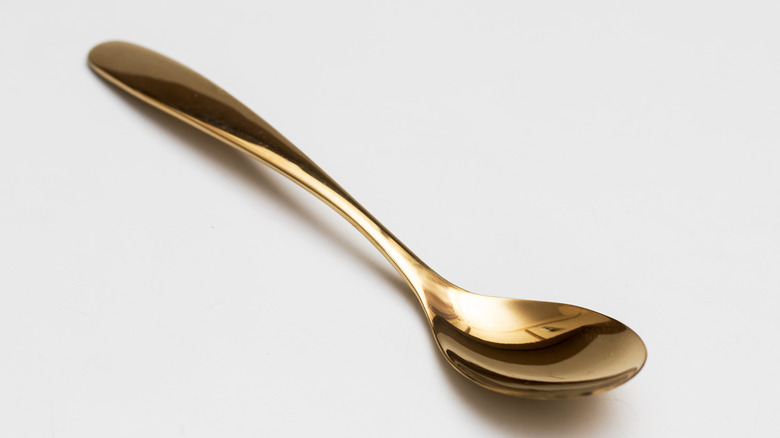Ice Cream: 19 Sweet Facts About The Popular Dessert
Whether they're into vanilla, rocky road, or mint chocolate chip, most Americans love Ice cream. But have you ever wondered if there's more to this delicious dessert? Even if you've eaten ice cream every day of your life, you likely don't know everything about it. The untold truth of ice cream include tales of American presidents, a cone that could hold enough ice cream to feed over 10,000 people, and even (weirdly), oysters.
We eat a lot of ice cream
I consider ice cream one of my guilty pleasures, so learning that the average American eats 22 pounds of ice cream a year made me breathe a sigh of relief. Now I can indulge with the knowledge that my fellow Americans are also scarfing down this delicious dessert with abandon.
The International Dairy Foods Association reported that "U.S. ice cream companies made more than 872 million gallons of ice cream in 2014." Unsurprisingly, the summer months are the most popular time for eating ice cream and more ice cream is produced in June than in any other month. In 2012, based on credit card transactions, D.C. ate the most ice cream of any state in the US.
Ice cream cones were born out of desperation
In the early 1900s, two unrelated immigrants to America — one Italian and one Syrian — "invented" the ice cream cone a year apart from each other. An Italian named Italo Marchiony, who had immigrated to the US in the late 1800s, was granted an ice cream cone patent in 1903. But that's not when ice cream cones really took off.
At the St. Louis World's Fair, a Syrian named Ernest A. Hamwi was selling zalabis, essentially Syrian waffle treats, when the ice cream seller next to him ran out of dishes. In true entrepreneurial fashion, Hamwi shaped one of his zalabis into a cone and gave it to the ice cream seller. The ice cream seller's predicament became Hamwi's success, and ice cream cones were finally on the map.
Hamwi went on to open the Missouri Cone Company and in the 1950s, The International Association of Ice Cream Manufacturers named him the inventor of the ice cream cone. Other accounts attribute the ice cream cone to different inventors, but one thing's for sure — the St. Louis World Fair did spread the popularity of the cones.
Ice cream sundaes were originally only sold on Sundays
Much like the origin story of ice cream cones, there are multiple accounts of the first ice cream sundaes. All accounts agree on one thing, though — the name ice cream sundae started because they were served on Sundays. In one version of the origin story, a law passed in 1890 prevented the sale of soda water on Sundays in Evanston, Illinois. In response, the soda fountains began selling ice cream sodas without the soda —essentially, ice cream sundaes.
The second version takes place in 1881 in Two Rivers, Wisconsin, when George Hallauer asked soda fountain owner Ed Berners if he would add chocolate syrup to his ice cream. Berner then added it to his regular menu. George Giffy, the owner of the ice cream shop in a nearby town, decided to serve the same thing to his customers, and he only sold it on Sundays.
In the third version, Chester Platt, a drugstore owner in Ithaca, New York, served Reverend John Scott vanilla ice cream with chocolate syrup and a candied cherry on (you guessed it) Sundays.
Ice cream trucks and Good Humor bars have something in common
Harry Burt, the inventor of Good Humor bars, is also credited for masterminding the idea of ice cream trucks. One night in 1920, Burt's son had the idea to combine ice cream and lollipop sticks — thus coming up with one of the best inventions since the ice cream sundae, the Good Humor bar. According to Country Living, he was already delivering ice cream when the Good Humor bar was invented. The ease in which the bars could be eaten gave him the idea to sell them directly to customers on the street.
There's a cure for ice cream headaches
You know that painful brain freeze you get when you eat your ice cream too quickly? Well, Dr. Jorge Serrador, a cardiovascular electronics researcher, actually did a medical study to find out how to cure it. He recruited 13 healthy adult volunteers, had them sip ice cold water, and then monitored the blood flow to their brains.
What they found out is that essentially, your brain tries to protect itself from the change in temperature by flooding blood into the area. If you want to get rid of your ice cream headache, just warm up your palate by drinking warm water or putting your tongue up to your palate.
Apparently, ice cream headaches do have a purpose, and it's not just to get you to eat your ice cream more slowly!
Ice cream can kill you (literally)
Unfortunately, ice cream stories don't all have a sweet ending. According to Country Living, before milk was pasteurized in the late 1800s, ice cream poisonings were a common occurrence. "Newspapers described ice cream poisoning epidemics in which dozens of fair-goers, picnic attendees, and party guests were stricken or killed."
Luckily, ice cream epidemics aren't common today, but they're not gone completely. From January 2010 to January 2015, ten cases of listeria infection broke out in four different states. Three of the patients, all living in Kansas, died of their illnesses. For a long time, no one could figure out where the listeria was coming from. That is, until a team from the South Carolina Department of Health linked the listeria cases with Blue Bell ice cream. Blue Bell later recalled all of its products in Texas and Oklahoma — the states where their factories had been linked to the outbreaks.
There's a recipe for oyster ice cream
The Virginia Housewife, written by Mary Randolph in 1860, included a recipe for oyster ice cream, which basically called for freezing oyster soup. This very brief recipe can be found in between recipes for chocolate ice cream and calf's foot jelly. (And you thought the oyster ice cream sounded gross.)
Much speculation has been given about this oyster ice cream recipe. Was it actually meant to be a dessert? Why did she include it in her recipe book?
In The Virginian Pilot, Lorraine Eaton shared the story of making a batch of oyster ice cream after her 10-year-old daughter brought it up during a family game. She couldn't force herself to eat it, but brought it to work, where it received mixed reviews. "One foodie said she could see it being served as an appetizer, perhaps with some Ritz crackers. Others found it OK. One person emerged from the ladies' room rubbing her tongue with a piece of paper towel. She had nearly thrown up."
I think I'm just going to stick with cookies and cream.
Penn State has an ice cream course
You may not think of ice cream as a subject worthy of a prestigious university, but Penn State thinks differently. Their ice cream creamery, the Berkey Creamery, opened in 1865 and has been serving up delicious ice cream — and science-based research about how to make ice cream — ever since.
The Berkey Creamery website proudly states they're "a world authority on ice cream and dairy manufacturing." They also outline their 12-step ice cream making process, which includes milking a herd of over 200 Holsteins twice daily, and keeping their ice cream mixture at 37 degrees for 24 hours in a special tank.
If you want to learn more about how to make ice cream with science based methods, you can sign up to attend their Ice Cream Short Course, which boasts attendance by Baskin-Robbins, Ben and Jerry's, and Good Humor/Breyers, among others.
The tallest ice cream cone ever was over 10 feet tall
Can you guess where the tallest ice cream cone ever was made? If you guessed Italy, you would have been correct — until 2015. That's when Hennig-Olsen, a Norway-based ice cream company, built their colossal cone, measuring over 10 feet tall. A helicopter airlifted the cone to Kristiansand in Southern Norway, where the gigantic cone, weighing almost a ton, was placed in a special cone holder.
They then filled the huge cone with enough strawberry ice cream to feed 10,800 people two scoops each. The cone also contained 15 gallons of chocolate and 242 pounds of waffle biscuit. Paal Hannig-Olsen, the current owner of Hennig-Olsen, told Guinness World Records, "The atmosphere was fantastic, and it was great to be able to share such a massive ice cream moment with everyone present."
Ice cream is way older than you think
Ice cream has a long and varied history that might go all the way back to the time of Alexander the Great over two thousand years ago — depending on who you ask. Some say the Romans invented it as early as 54-68 BC, when they mixed ice with flavors and then drank it — but that's not much like the ice cream we know. Another account comes from China in 618 BC, when Tang Dynasty emperors ate 'a frozen milk-like confection.' This version was made with cow, goat or buffalo milk that was heated with flour."
Ice cream probably reached Europe much later, in the 1600s, and it began appearing in English cookbooks by the 1700s.
The first known account of ice cream in the United States happened in 1744, at Governor Thomas Bladen's home. According to The Colonial Williamsburg Foundation, one of his guests wrote, "a Dessert no less curious: Among the Rarities of which it was Compos'd, was some fine Ice Cream which, with the Strawberries and Milk, eat most Deliciously."
A royal governor once turned hail into ice cream
In one of the more interesting early accounts of ice cream, Governor Francis Fauquier, the royal governor of Williamsburg, used hail to make ice cream for himself in 1758. According to The Colonial Williamsburg Foundation, hailstones were collected, likley by order of the governor, after a violent storm and used to cool wine and freeze cream.
He likely reacted this way due to the difficulty of storing ice at the time. The next time you find yourself enjoying a bowl of ice cream, be grateful you can just grab it from the freezer instead of desperately collecting hail to mix with cream!
Thomas Jefferson helped make it popular
Thomas Jefferson loved to serve his guests ice cream and wrote the first known American ice cream recipe. According to the Thomas Jefferson Foundation, one of his guests said, "Among other things, ice creams were produced in the form of balls of the frozen material enclosed in covers of warm pastry, exhibiting a curious contrast, as if the ice had just been taken from the oven."
Jefferson went to France from 1784-1789 and returned to the US with four ice molds, and later acquired an ice cream ladle and an ice cream freezer. His love for ice cream helped make it popular among Americans.
His ice cream recipe is one of only ten surviving recipes in his handwriting, and is attributed to his French butler, Adrien Petit. You can still try out his original recipe, which is available on the Thomas Jefferson Foundation website.
You can buy fried chicken ice cream
Do you remember that dark time in our not-so-far-back history when we'd all watch in horror as everyday items were sliced and it turned out that they were all hyper-realistic cakes? From bags of potato chips and raw steaks to screwdrivers and handbags, many joked that they too might not be human but a giant wad of cake. As it turns out though, cake is not the only thing that can be transformed into a perfect optical illusion.
At Life Raft Treats, you can merge your love for fried chicken and your love for ice cream with the "Not Fried Chicken" ice cream bar. According to Southern Living, Cynthia Wong's creation started out as a groggy joke to herself. Soon enough, her ice cream fried chicken drumstick came together as she made the chicken bone using a cookie, some waffle-flavored ice cream for the chicken, and a mix of white chocolate and cornflakes for that oh so delicious fried chicken crunch. Since opening Life Raft Treats' doors in 2018, Wong and her team have gone on to delight patrons with other ice cream creations like the Naughty Emojis Pack for Valentines Day (which includes the eggplant, peach, hotdog, and donut emojis) and wholesome Thanksgiving packs with a turkey and all the fixings!
These are the most popular ice cream flavors
As with most other treats, chocolate and vanilla's standing as the most popular ice cream flavor will oscillate depending on who you ask. However, with those two out of the way, the other eight most popular ice cream flavors of 2022 were, in order, the following: mint chocolate, cookie dough, buttered pecan, Neapolitan, banana, toffee, caramel, and dark chocolate.
Honorable mentions include the indulgent vanilla ice cream-fudge-peanut butter cups mix that is Moose Tracks, trusty strawberry, and cookies and cream. If you're all about the childhood nostalgia, we of course cannot ignore Birthday Cake flavored ice cream, clad with delicious buttercream frosting, funfetti – because who doesn't love funfetti? — and yummy bits of actual cake. In case you're wondering how cookies and cream differs from cookie dough ice cream, the former includes baked cookie bits while the latter is instead filled with little chunks of real cookie dough.
The most popular ice cream toppings
There's nothing quite like visiting the ice cream shop and getting to go wild on all manner of combinations with your toppings. One thing Thrillist and Restaurant Clicks independently made clear is that hot fudge is the topping of all toppings. Not only is it the perfect mix of hot and cold on the palette, it can elevate and add dimension to other, more demure toppings. Fresh fruit is another topping that is set to stand out, as it's the only one that will inject a dose of freshness to whatever flavor you fancy.
Other popular toppings, in no particular an order, include bits of candy – ranging from gummies and marshmallow pieces to peanut butter cups, and classic sauces like strawberry, caramel, and chocolate. For those who like their ice cream with an air of being grown, there are chopped nuts, maraschino cherries and whipped cream. If you're all about the tried and trusted, a hard chocolate coating or crushed Oreo cookies will never let you down, while sprinkles and cereals will almost always have you feeling like a kid again.
How much milk is needed to make a gallon of ice cream?
If you've ever wondered how much milk it actually takes to make ice cream, the numbers may surprise you. Apart from all the sugar, eggs, and air (yes – air is a crucial component of ice cream making), by the time you get to enjoy a satisfying spoonful of ice cream, three gallons of fresh milk will have been used for every gallon of it. Because the average cow typically produces about six gallons of milk in a single day, if you wanted to make a gallon of ice cream, one day of hard lactating work would not be enough to make it!
As if that weren't already a whole lot of milk, perhaps even more surprising is that making chocolate-flavored ice cream entails using more fresh milk than other flavors. Because milk is already a key component in milk chocolate, there's that added layer when pairing this flavor with ice cream.
There are some health benefits to eating chocolate ice cream
If you've ever wanted to retort that you were eating ice cream as medicine (and not just for heartbreak), you'll be happy to find that there are some health benefits associated with chocolate ice cream. In addition to carbs, fats, and protein, chocolate ice cream contains a range of minerals and vitamins including calcium, magnesium, phosphorous, potassium, sodium, and vitamin C.
Together they may aid in the prevention of heart disease — thanks to the flavanols found in cocoa, which support blood pressure and blood flow. It may also lower risk of stroke while improving your ability to perform in sports and exercise. Additionally, because ice cream contains calcium and magnesium, it may support muscle and overall immune function. Ultimately though, ice cream still contains large amounts of sugar. As such, if it's the health benefits of the chocolate you're especially after, your overall diet will fare better with plain dark chocolate.
Chocolate ice cream was invented before vanilla
Many people assume that vanilla was the original ice cream flavor, but it turns out that chocolate ice cream was invented before vanilla. It also turns out that long before ice cream churners where a thing, thanks to sweet will, all you needed was a little bit of ice and some sugar to create sherberts in the Middle East. Across the sea, other frozen drinks/desserts were also making their way to the sweet treat fore as the first frozen chocolate drink was published in Italy during 1692. It was from these roots that the modern day chocolate ice cream emerged.
By 1775, it started making the rounds as a medicinal treatment when Filippo Baldini, an Italian doctor, suggested that it could be consumed for the treatment of gout and scurvy. A little over five years later, vanilla ice cream made its way to the U.S. after Thomas Jefferson had a taste in France. Fast forward to 1961 when other ice cream flavors started to enter the market. Enrico Panattoni created stracciatella ice cream — derived from the soup. In 1973, mint chocolate ice cream was created when Marilyn Ricketts — a culinary student — made it for a competition to have an ice cream treat featured at Princess Anne's wedding. More recently, the makings of what would later become salted caramel ice cream was created when Pierre Hermé, a French chef, made a salted caramel macaron in the 1990s.
Ice cream taste testers use gold spoons
There are many cool jobs, but some sound too cool – literally and figuratively – to be real. Being an ice cream tester is, without a doubt, among those. Unless you're John Harrison, of course. According to Cooking Light, Harrison has not only tested more than 60 ice cream samples at Edy's Grand Ice Cream, he's also perfected quite a meticulous testing process along the way.
This is what it entails: first, an eye test — if it doesn't look yummy, it's not worth the sacrifice of his taste buds. Second, the sample is left to temper down to between 10 and 12 degrees for an optimal assessment of aroma, bouquet, flavor, and top notes. Next, only a gold-plated spoon is used to scoop up the sample. This is because other spoons have an aftertaste that may adversely impact the testing. The ice cream is then given a good mouth swirl, and then — shock — it is spat out. Harrison's taste buds are so coveted that they have even been insured for one million dollars. Ah! What a miserable, miserable, job!
